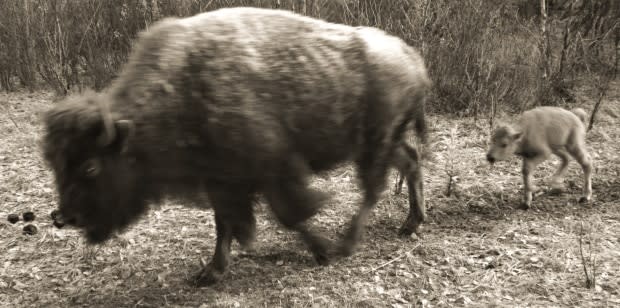Baby boom adds 10 calves to bison population in Banff
A baby boom has nearly tripled the population of bison in Banff, and it's big news for the national park — it has resulted in the first made-in-Banff bison mother in more than 140 years.
Sixteen plains bison were transported to Banff from Elk Island National Park in 2017, and according to wildlife biologist Karsten Heuer — the park's bison reintroduction project manager — the population has now grown to about 45.
He spent the last few days in the backcountry observing the bison calves, and said they have already begun to change the dynamic among the adults in the herd.
"It was a pretty incredible scene," Heuer said.
"Just all these beautiful red calves, frolicking in this meadow — and in a cheeky way, going up to their mothers and the other adult bison, and trying to provoke them, and actually injecting a huge amount of playfulness among the herd."
The predator-prey dance
As bison have become wilder in Banff, they have also been harder to track and photograph.
But Heuer said the calves were discovered with the use of remote cameras in the park.
At about 50 pounds, he said the calves look small when juxtaposed to their 1,000-pound mothers, but are otherwise quite sizeable.
They are also striking — with rust-coloured fur, Heuer said they stand out vibrantly against their "chocolatey" adult counterparts.
Some experts believe, Heuer said, that their fur matches the reddish hue of the legs of adult bison so that when escaping predators, they are camouflaged as they run near their parent's legs.

"It's thought that the rusty-red tinge of the bison calves confuses predators if they're approaching, and the bison are fleeing," Heuer said.
"[The] image is confused by the red of the calves, mixing with the red of the mother's legs."
And as for predators in Banff, park employees lost track of one bison calf last September that they believe died of natural causes — or fell victim to wolves. But right now, the two populations seem more curious about each other than aggressive.
"Interestingly enough, as the wolves have approached, the bison really haven't budged. There's been no indication that they've been disturbed," Heuer said.
"I think that wolves have been quite curious ... and in fact, some of the remote camera imagery shows the bison following the wolves after the wolves have followed the bison. So it's, I think, a mutual curiosity as they figure out, you know, their respective roles in this age of predator-prey dance, which we do hope eventually starts to happen."
Breeding patterns normalizing
According to Heuer, the bison in Banff have been out of sync with calving season — which typically sees bison calves arrive in May or June — and instead calving throughout the summer and even into the fall.
Now having had time to adjust, he said the cycle is beginning to normalize.
"We released them during the breeding season, which was probably a little bit chaotic and confusing for them, and maybe they didn't hook up at the right times," Heuer said.
"But now, they seem to be getting back on schedule, and more into the natural pattern."
For Heuer, who has worked with Parks Canada for 25 years, reintroducing bison — and seeing their numbers grow — has been what he calls "an opportunity of a lifetime."
"Oh, it's been an honour ... I think it's every wildlife biologist's dream to be working something like trying to reintroduce Canada's largest land mammal into its first national park," he said.
"To witness the return of this major herbivore, and also to actually see them unearthing their ancestor's bones … we realize that they're revisiting and reactivating these places that their ancestors used, hundreds and even thousands of years ago. It really is quite moving."
